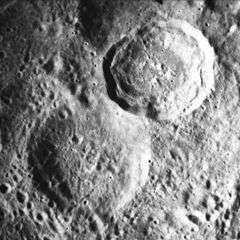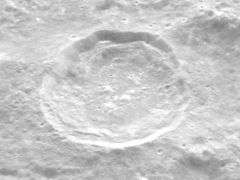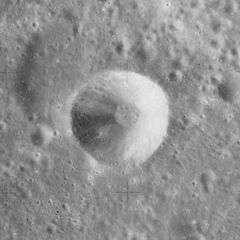Schorr (crater)
Schorr is a lunar impact crater that lies across the eastern limb of the Moon. From the Earth this crater is viewed from the side, limiting the amount of detail that can be observed. The visibility of this crater is also affected by libration of the Moon in its orbit. The crater lies just to the northwest of the walled plain Curie, and to the east-southeast of the crater Gibbs.
 Schorr (upper right) and Schorr A (lower left), from Apollo 15 | |
| Coordinates | 19.5°S 89.7°E |
|---|---|
| Diameter | 53 km |
| Depth | Unknown |
| Colongitude | 271° at sunrise |
| Eponym | Richard Schorr |

When viewed from orbit, this appears as a circular crater with an outer rim that has not been significantly worn through impact erosion. The material along the inner walls has accumulated along the bottom of the sloping sides, forming a ledge along parts of the base. The interior floor is irregular in places, with low ridges crossing parts of the bottom. Schorr intrudes slightly into the satellite crater Schorr A to the southeast.
Satellite craters

By convention these features are identified on lunar maps by placing the letter on the side of the crater midpoint that is closest to Schorr.
| Schorr | Latitude | Longitude | Diameter |
|---|---|---|---|
| A | 20.5° S | 88.4° E | 64 km |
| B | 16.5° S | 88.5° E | 26 km |
| C | 13.5° S | 88.2° E | 13 km |
| D | 18.6° S | 91.2° E | 21 km |
See also
- Asteroid 1235 Schorria
References
- Andersson, L. E.; Whitaker, E. A. (1982). NASA Catalogue of Lunar Nomenclature. NASA RP-1097.CS1 maint: ref=harv (link)
- Blue, Jennifer (July 25, 2007). "Gazetteer of Planetary Nomenclature". USGS. Retrieved 2007-08-05.CS1 maint: ref=harv (link)
- Bussey, B.; Spudis, P. (2004). The Clementine Atlas of the Moon. New York: Cambridge University Press. ISBN 978-0-521-81528-4.CS1 maint: ref=harv (link)
- Cocks, Elijah E.; Cocks, Josiah C. (1995). Who's Who on the Moon: A Biographical Dictionary of Lunar Nomenclature. Tudor Publishers. ISBN 978-0-936389-27-1.CS1 maint: ref=harv (link)
- McDowell, Jonathan (July 15, 2007). "Lunar Nomenclature". Jonathan's Space Report. Retrieved 2007-10-24.CS1 maint: ref=harv (link)
- Menzel, D. H.; Minnaert, M.; Levin, B.; Dollfus, A.; Bell, B. (1971). "Report on Lunar Nomenclature by the Working Group of Commission 17 of the IAU". Space Science Reviews. 12 (2): 136–186. Bibcode:1971SSRv...12..136M. doi:10.1007/BF00171763.CS1 maint: ref=harv (link)
- Moore, Patrick (2001). On the Moon. Sterling Publishing Co. ISBN 978-0-304-35469-6.CS1 maint: ref=harv (link)
- Price, Fred W. (1988). The Moon Observer's Handbook. Cambridge University Press. ISBN 978-0-521-33500-3.CS1 maint: ref=harv (link)
- Rükl, Antonín (1990). Atlas of the Moon. Kalmbach Books. ISBN 978-0-913135-17-4.CS1 maint: ref=harv (link)
- Webb, Rev. T. W. (1962). Celestial Objects for Common Telescopes (6th revised ed.). Dover. ISBN 978-0-486-20917-3.CS1 maint: ref=harv (link)
- Whitaker, Ewen A. (1999). Mapping and Naming the Moon. Cambridge University Press. ISBN 978-0-521-62248-6.CS1 maint: ref=harv (link)
- Wlasuk, Peter T. (2000). Observing the Moon. Springer. ISBN 978-1-85233-193-1.CS1 maint: ref=harv (link)